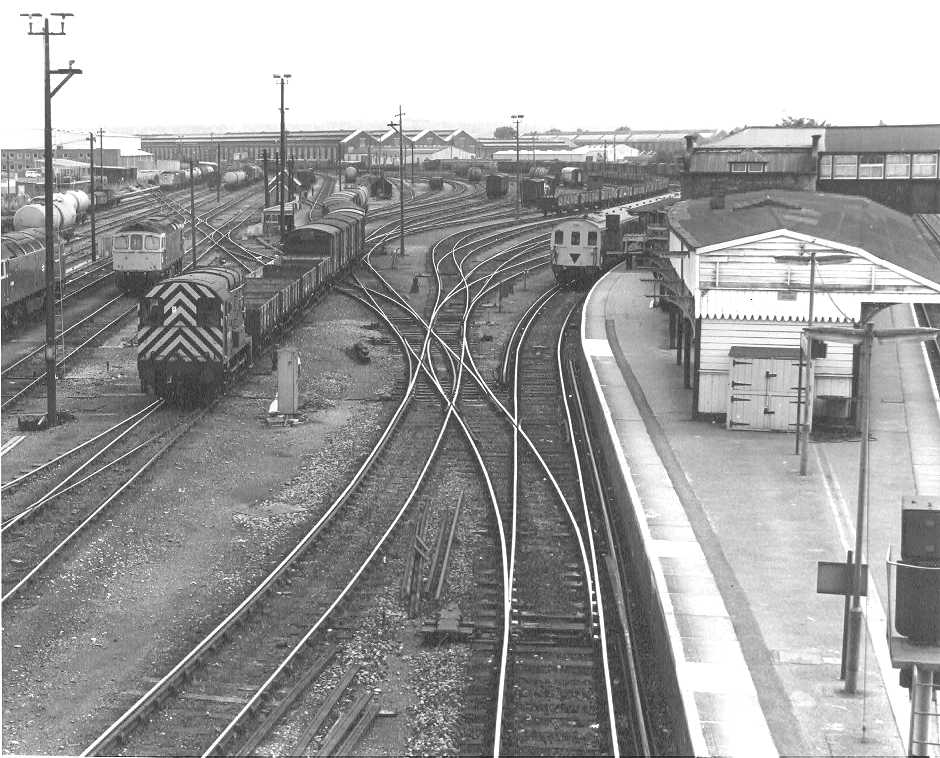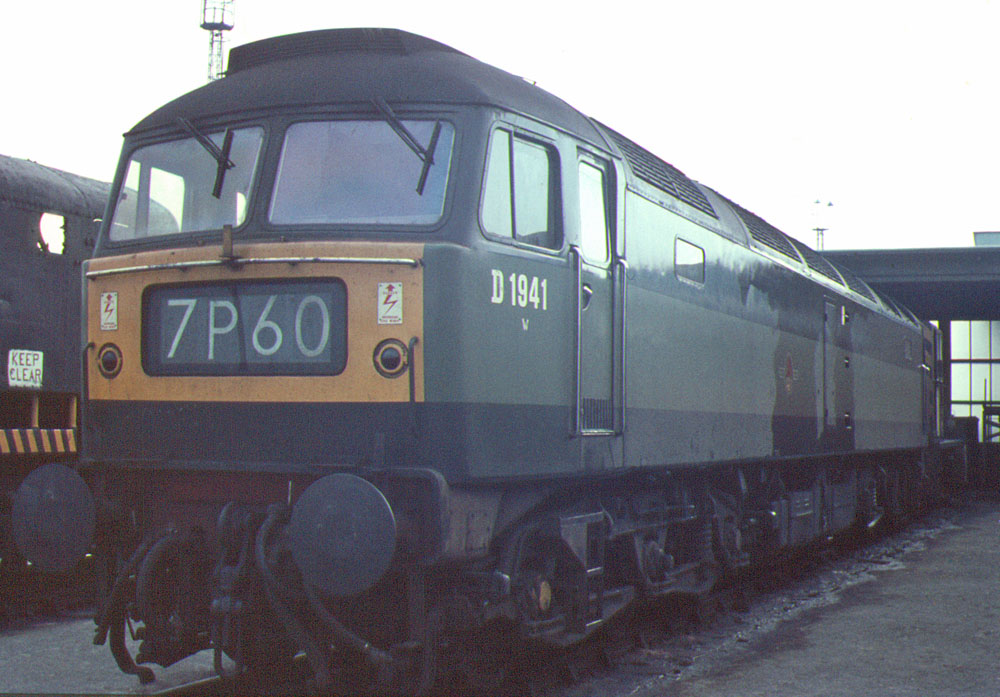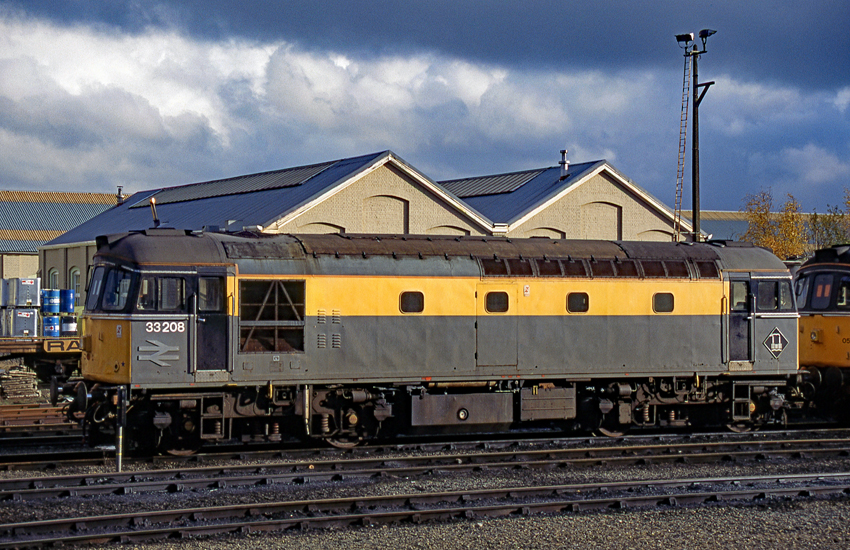|
Eastleigh Train And Rolling Stock Maintenance Depot
Eastleigh Depot is a depot location in Eastleigh, Hampshire, England. The depot is situated on the South West Main Line and is near Eastleigh station. The depot code is EH. History In 1903, the London & South Western Railway opened a 15-road locomotive shed, it closed in 1967. A two road diesel shed was opened by British Railways opened in 1958. The main shed being a four-track dead-ended shed which was extended south in 1965, and also with a four-track through-road extension on the western side. The second building is a one-track through road shed, for fuelling, which was opened in 1998. Around 1987, the depot's allocation consisted of Classes 08, 09 and 33 locomotives and Classes 204 and 205 DEMUs. Classes 47 and 73 could also be seen stabled at the depot. Allocation As of 2018, the depot is operated by Arriva TrainCare servicing CrossCountry Class 220 and 221 __NOTOC__ Year 221 ( CCXXI) was a common year starting on Monday of the Julian calendar. At the time, ... [...More Info...] [...Related Items...] OR: [Wikipedia] [Google] [Baidu] |
Eastleigh
Eastleigh is a town in Hampshire, England, between Southampton and Winchester. It is the largest town and the administrative seat of the Borough of Eastleigh, with a population of 24,011 at the United Kingdom 2011 census, 2011 census. The town lies on the River Itchen, Hampshire, River Itchen, one of England's premier chalk streams for fly fishing, and a designated site of Special Scientific Interest. The area was originally villages until the 19th century, when Eastleigh was developed as a railway town by the London and South Western Railway. History The modern town of Eastleigh lies on the old Ancient Rome, Roman road, built in A.D.79 between Winchester ''(Venta Belgarum)'' and Bitterne ''(Clausentum)''.#Gosling69, Nicola Gosling: 1986, Page 4 Ancient Rome, Roman remains discovered in the Eastleigh area, including a Roman lead coffin excavated in 1908, indicate that a settlement probably existed here in Roman times. A Saxons, Saxon village called 'East Leah' has been re ... [...More Info...] [...Related Items...] OR: [Wikipedia] [Google] [Baidu] |
British Rail Class 204
The British Rail Class 204 designation has been used twice for two similar types of diesel-electric multiple units. History The original units, numbered in the range 1119-1122, were two-car versions of the Class 205 '3H' units, and were classified as 2H under the old system. In 1979, BR decided to augment the two-car units to three-car formation. Three of the four units were reformed with the addition of centre trailers taken from 3H (Class 205) units, and thus were themselves reclassified as Class 205. The fourth 2H unit, and the three former 3H units which had given up their trailers, were augmented by reusing the ex- 2EPB driving trailers from redundant Class 206 units. The Class 204 designation was re-applied to these four newly formed units (which were also given the classification 3T under the old system). They were renumbered into the range 1401-1404. In 1986, the units were renumbered to 204001-004 to conform with the TOPS numbering system. Technical details Power ... [...More Info...] [...Related Items...] OR: [Wikipedia] [Google] [Baidu] |
Railway Depots In South East England
Rail transport (also known as train transport) is a means of transport using wheeled vehicles running in tracks, which usually consist of two parallel steel rails. Rail transport is one of the two primary means of land transport Land transport is the transport or movement of people, animals or goods from one location to another location on land. This is in contrast with other main types of transport such as maritime transport and aviation. The two main forms of land tr ..., next to road transport. It is used for about 8% of passenger and rail freight transport, freight transport globally, thanks to its Energy efficiency in transport, energy efficiency and potentially high-speed rail, high speed.Rolling stock on rails generally encounters lower friction, frictional resistance than rubber-tyred road vehicles, allowing rail cars to be coupled into longer trains. Power is usually provided by Diesel locomotive, diesel or Electric locomotive, electric locomotives. While railway t ... [...More Info...] [...Related Items...] OR: [Wikipedia] [Google] [Baidu] |
Today's Railways UK
''Today's Railways UK'' is an English-based monthly magazine covering rail transport in Great Britain. It was founded by Platform 5 in January 2002 as ''Entrain'' as a sister publication to '' Today's Railways Europe'', in January 2006 it was rebranded as ''Today's Railways UK''. The magazine was set up by Peter Fox, who wrote a monthly "Grumpy Old Man" Column. It is owned by Platform 5 publications. Fox was editor-in-chief of the magazine until his death in 2011. Robin Sisson, the rail campaigner, worked for Today's Railways UK as assistant editor, under editor-in-chief Peter Fox, from 2006 until his death in 2008. Sisson wrote the monthly "Just the Ticket" feature. Production of the magazine was suspended in April 2020 due to the coronavirus Coronaviruses are a group of related RNA viruses that cause diseases in mammals and birds. In humans and birds, they cause respiratory tract infections that can range from mild to lethal. Mild illnesses in humans include some case ... [...More Info...] [...Related Items...] OR: [Wikipedia] [Google] [Baidu] |
British Rail Class 221
The British Rail Class 221 ''Super Voyager'' is a class of tilting train, tilting Diesel-electric transmission, diesel-electric multiple unit express passenger trains built in Bruges, Belgium and Wakefield, by Bombardier Transportation in 200102. The class is similar to the British Rail Class 220, Class 220 ''Voyager'', but was built with a tilting train, tilting mechanism enabling up to six degrees of tilt to allow higher speeds on curved tracks. Additionally, most have five coaches, and they have a different bogie design. They have a maximum speed of . The trains are divided between two operators, CrossCountry (25 sets) and Grand Central (train operating company), Grand Central (two sets). CrossCountry sets had their tilt function disabled in 2008 to improve reliability and reduce maintenance costs, and Grand Central sets do not use theirs, although they remain in place. There are also a number of additional sets in storage, having been stood down from Avanti West Coast in ... [...More Info...] [...Related Items...] OR: [Wikipedia] [Google] [Baidu] |
British Rail Class 220
The British Rail Class 220 ''Voyager'' is a class of diesel-electric high-speed multiple unit passenger trains built in Belgium by Bombardier Transportation in 2000 and 2001. They were introduced in 2001 to replace the 20-year-old InterCity 125 and almost 40-year-old Class 47-hauled Mark 2 fleets operating on the Cross Country Route. They were initially operated by Virgin CrossCountry and since 2007 have been operated by CrossCountry. Technical details All coaches are equipped with a Cummins QSK19 diesel engine of at 1,800rpm. These power a generator which supplies current to motors driving two axles per coach, with one axle per bogie powered. Voyagers have both air and rheostatic brakes. They are fitted with Dellner couplers, like the Class 222 operated by East Midlands Railway and the Class 390 ''Pendolino'' electric trains used by Avanti West Coast, meaning they can be coupled in rescue/recovery mode (air brake only) in the event of a failure. 220s and 221s can ... [...More Info...] [...Related Items...] OR: [Wikipedia] [Google] [Baidu] |
CrossCountry
CrossCountry (legal name XC Trains Limited) is a British train operating company owned by Arriva UK Trains, operating the current CrossCountry franchise. The CrossCountry franchise was restructured by the Department for Transport (DfT) in 2006, incorporating elements of both the Central Trains and the Virgin CrossCountry franchises, ahead of its invitation to tender on October of that year. On 10 July 2007, the DfT announced that Arriva had been awarded the New Cross Country franchise. CrossCountry is one of only two franchised train operating companies that does not manage any stations, the other being Caledonian Sleeper. CrossCountry's services have been periodically disrupted by industrial action amongst its staff, often due to disputes over rostering and pay. While the franchise had been originally due to conclude on 31 March 2016, multiple subsequent agreements have been enacted; in September 2023, the DfT confirmed that the franchise has been extended for a further four yea ... [...More Info...] [...Related Items...] OR: [Wikipedia] [Google] [Baidu] |
British Rail Class 73
The British Rail Class 73 is a British electro-diesel locomotive. This type is unusual in that it can operate on the Southern Region's 650 / 750 V DC third rail power supply, or an onboard diesel engine to allow it to be used on non-electrified routes. This makes it very versatile, although the diesel engine produces less power than is available from the third-rail power supply, so the locomotives are rarely used outside of the former Southern Region of British Railways, Southern Region of British Rail. It is one of the first bi-mode locomotives ever built. Following the withdrawal and scrapping of the more powerful British Rail Class 74, Class 74 bi-mode locomotives in 1977, the Class 73 was unique on the British railway network until the introduction of the British Rail Class 88, Class 88 bi-mode locomotives in 2017. Ten locomotives have been scrapped. History The Southern Railway (UK), Southern Railway's expanding third rail electric passenger network (which had begu ... [...More Info...] [...Related Items...] OR: [Wikipedia] [Google] [Baidu] |
British Rail Class 47
The British Rail Class 47 or Brush Type 4 is a class of diesel-electric locomotive that was developed in the 1960s by Brush Traction. A total of 512 Class 47s were built at Brush's Falcon Works in Loughborough and at British Railways' Crewe Works between 1962 and 1968, which made them the most numerous class of British mainline diesel locomotive. They were fitted with the Sulzer (manufacturer), Sulzer 12LDA28C U engine, twin-bank twelve-cylinder unit producing though this was later derated to to improve reliabilityand have been used on both passenger and freight trains on Britain's railways for over 55 years. Despite the introduction of more modern types of traction, a significant number are still in use, both on the mainline and on heritage railways. , 76 locomotives still exist as Class 47s, including 32 which have been preserved. 31 locomotives, including six which are preserved, retain mainline running certificates. A further 33 locomotives were converted to British Rail ... [...More Info...] [...Related Items...] OR: [Wikipedia] [Google] [Baidu] |
British Rail Class 205
The British Rail Class 205 (Southern Railway multiple unit numbering and classification, 3H) diesel-electric multiple units were built by BR at Eastleigh railway works, Eastleigh from 1957 to 1962, and in service for 47 years from BR Southern Region to Connex South Central and finally to the Southern (Govia Thameslink Railway), Southern franchise. They were eventually replaced by British Rail Class 171, Class 171 Turbostar units. Description This class of unit was built in four different batches for use on different lines. The Southern Region class 201 to 207 DEMUs are nicknamed 'Thumpers' owing to the noise they made while in motion. The first batch of units, numbered 1101–1118, was built in 1957 as two-car units and classified as 2H. They were built for services in Hampshire on the non-electrified routes between , and and between , and . The first units entered service in September 1957. However, owing to increasing passenger numbers, all eighteen units were strengthene ... [...More Info...] [...Related Items...] OR: [Wikipedia] [Google] [Baidu] |
British Rail Class 33
The British Rail Class 33, also known as the BRCW Type 3 or Crompton, is a class of Bo-Bo diesel-electric locomotives, ordered in 1957 and built for the Southern Region of British Railways between 1960 and 1962. They were produced as a more powerful Type 3 (1,550 bhp) development of the 1,160 bhp Type 2 Class 26. This was achieved, quite simply, by removing the steam heating boiler and fitting a larger 8 cylinder version of the previous 6 cylinder engine. This was possible because of the traffic requirements of the Southern Region: locomotive-hauled passenger traffic depended on seasonal tourist traffic and was heavier in the summer, when carriage heating was not needed. In the winter, their expected use was to be for freight. Thus, they became the most powerful BR Bo-Bo diesel locomotive. The perennially unreliable steam heating boiler could also be avoided. A total of 98 were built by the Birmingham Railway Carriage and Wagon Company (BRCW) and they were known a ... [...More Info...] [...Related Items...] OR: [Wikipedia] [Google] [Baidu] |






